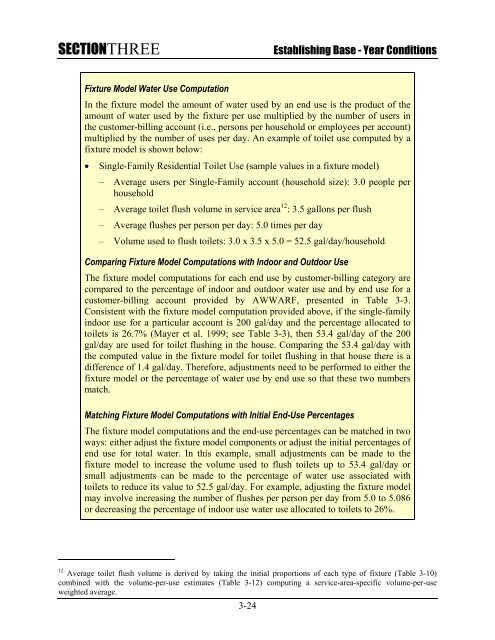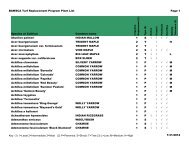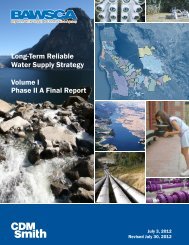SFPUC Wholesale Customer Water Demand Projections ... - BAWSCA
SFPUC Wholesale Customer Water Demand Projections ... - BAWSCA
SFPUC Wholesale Customer Water Demand Projections ... - BAWSCA
Create successful ePaper yourself
Turn your PDF publications into a flip-book with our unique Google optimized e-Paper software.
SECTIONTHREE<br />
Establishing Base - Year Conditions<br />
Fixture Model <strong>Water</strong> Use Computation<br />
In the fixture model the amount of water used by an end use is the product of the<br />
amount of water used by the fixture per use multiplied by the number of users in<br />
the customer-billing account (i.e., persons per household or employees per account)<br />
multiplied by the number of uses per day. An example of toilet use computed by a<br />
fixture model is shown below:<br />
• Single-Family Residential Toilet Use (sample values in a fixture model)<br />
– Average users per Single-Family account (household size): 3.0 people per<br />
household<br />
– Average toilet flush volume in service area 12 : 3.5 gallons per flush<br />
– Average flushes per person per day: 5.0 times per day<br />
– Volume used to flush toilets: 3.0 x 3.5 x 5.0 = 52.5 gal/day/household<br />
Comparing Fixture Model Computations with Indoor and Outdoor Use<br />
The fixture model computations for each end use by customer-billing category are<br />
compared to the percentage of indoor and outdoor water use and by end use for a<br />
customer-billing account provided by AWWARF, presented in Table 3-3.<br />
Consistent with the fixture model computation provided above, if the single-family<br />
indoor use for a particular account is 200 gal/day and the percentage allocated to<br />
toilets is 26.7% (Mayer et al. 1999; see Table 3-3), then 53.4 gal/day of the 200<br />
gal/day are used for toilet flushing in the house. Comparing the 53.4 gal/day with<br />
the computed value in the fixture model for toilet flushing in that house there is a<br />
difference of 1.4 gal/day. Therefore, adjustments need to be performed to either the<br />
fixture model or the percentage of water use by end use so that these two numbers<br />
match.<br />
Matching Fixture Model Computations with Initial End-Use Percentages<br />
The fixture model computations and the end-use percentages can be matched in two<br />
ways: either adjust the fixture model components or adjust the initial percentages of<br />
end use for total water. In this example, small adjustments can be made to the<br />
fixture model to increase the volume used to flush toilets up to 53.4 gal/day or<br />
small adjustments can be made to the percentage of water use associated with<br />
toilets to reduce its value to 52.5 gal/day. For example, adjusting the fixture model<br />
may involve increasing the number of flushes per person per day from 5.0 to 5.086<br />
or decreasing the percentage of indoor use water use allocated to toilets to 26%.<br />
12 Average toilet flush volume is derived by taking the initial proportions of each type of fixture (Table 3-10)<br />
combined with the volume-per-use estimates (Table 3-12) computing a service-area-specific volume-per-use<br />
weighted average.<br />
3-24







